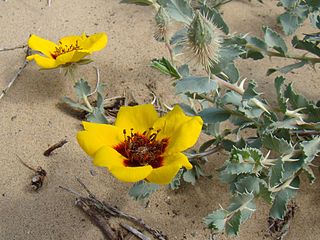
The Papaveraceae are an economically important family of about 42 genera and approximately 775 known species of flowering plants in the order Ranunculales, informally known as the poppy family. The family is cosmopolitan, occurring in temperate and subtropical climates, but almost unknown in the tropics. Most are herbaceous plants, but a few are shrubs and small trees. The family currently includes two groups that have been considered to be separate families: Fumariaceae and Pteridophyllaceae.

Parkinsonia, also Cercidium, is a genus of flowering plants in the pea family, Fabaceae. It contains about 12 species that are native to semi-desert regions of Africa and the Americas. The name of the genus honors English apothecary and botanist John Parkinson (1567–1650).

Corydalis is a genus of about 540 species of annual and perennial herbaceous plants in the family Papaveraceae, native to the temperate Northern Hemisphere and the high mountains of tropical eastern Africa. They are most diverse in China and the Himalayas, with at least 357 species in China.

Hatiora is a small genus of epiphytic cacti which belongs to the tribe Rhipsalideae within the subfamily Cactoideae of the Cactaceae. Recent taxonomic studies have led to the three species formerly placed in subgenus Rhipsalidopsis being removed from the genus, including the well known and widely cultivated ornamental plants known as Easter cactus or Whitsun cactus.

Nuphar lutea, the yellow water-lily, brandy-bottle, or spadderdock, is an aquatic plant of the family Nymphaeaceae, native to northern temperate and some subtropical regions of Europe, northwest Africa, western Asia, North America, and Cuba. This interesting species found on both sides of the Atlantic Ocean was used as a food source and in medicinal practices from prehistoric times with potential research and medical applications going forward.
Yellow corydalis is a common name for several plants and may refer to:
Pale corydalis is a common name used to refer to:

Corydalis flavula is an herbaceous perennial plant native to the eastern United States. Its natural habitat is open woods and slopes.

Pseudofumaria lutea, the yellow corydalis or rock fumewort, is a short-lived perennial plant in the poppy family Papaveraceae. It is native to the southern foothills of the south-western and central Alps of Italy and Switzerland, but widely introduced elsewhere.

Pseudofumaria alba is a short-lived perennial plant in the family Papaveraceae.

Arugisa is a genus of moths in the family Erebidae.

Ibicella lutea is a species of flowering plant known by the common name yellow unicorn-plant. It grows in dry conditions, such as those in desert regions. It is native to South America, but has become established as a non-native species in various semi-arid regions around the world, including Southern Africa and the Central Valley of California. The plant is aromatic, with an unpleasant scent. It produces short, glandular hairs over most of its aerial surfaces and is coated in sticky resin. Insects often become stuck in the slimy exudate and die, but the plant does not have digestive enzymes and does not absorb nutrients from the insects. The plant can be considered protocarnivorous, but it is not carnivorous.

Rosa persica is an anomalous species of rose that at one time was placed in a separate genus Hulthemia. It is native to deserts and steppes from Iran and Afghanistan in the south, through Central Asia, to western Siberia in the north. Its distinctive characteristics include a simple leaf without stipules, and a distinctive flower with a darker coloured central zone. In its natural habitat it is a deep-rooted weed that suckers – growing in Iranian fields for example, where it is collected for fuel once the grain crop has been harvested – but it is difficult to grow in gardens and rarely cultivated.

Blitum is a genus of flowering plants in the amaranth family Amaranthaceae, subfamily Chenopodioideae. It is closely related to genus Spinacia. Its 12 species were traditionally placed in the genera Chenopodium, Monolepis, or Scleroblitum. The species of genus Blitum occur in Asia, Europe, North Africa, the Americas, and Australia.

Phycella is a genus of herbaceous, perennial bulbous flowering plants belonging to the family Amaryllidaceae, subfamily Amaryllidoideae. The genus consists of five species distributed from central Chile to northwestern Argentina.













